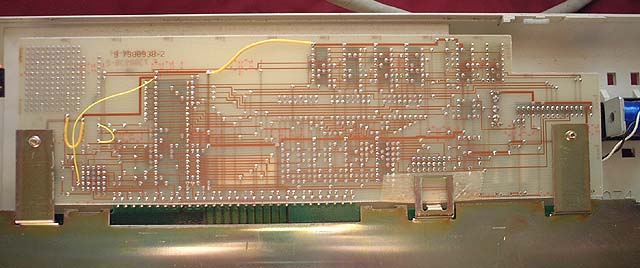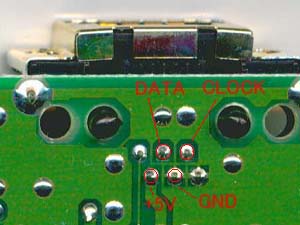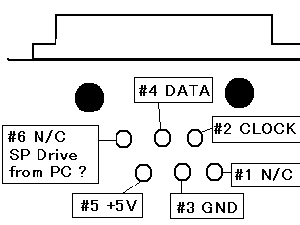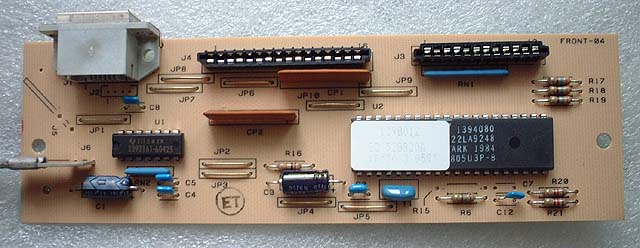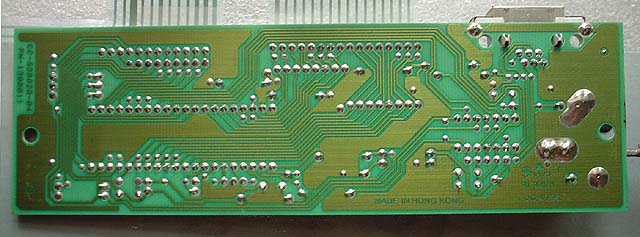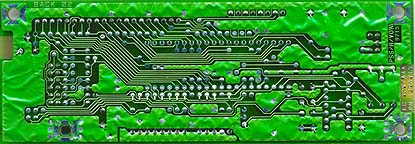|
Model M ; Buckling Spring Technology and
membrane switching system
Cut model of a Buckling spring key
Spring and platter
Replacing bad springs
Remove springs
Iside Model M
Repairing Model M
( reuse inner assembly )
Model F ; Buckling Spring Technology and Capacitive
switching system
A sample of capacitive switch keyboard .
p/n 5640991
Variations
of Control PCB
Pin out of SDL connector and PS/2 plug ( and AT DIN
plug )
Pin
out of J7 Terminal keyboard ( 5 pin header )
Translucent Key Caps ( From Korean web
site, United
Keyboard Mania by zoOoz )
English
translation, Japanese
translation
Model M can't be
recognized when connected to some modern mother board.
How to reduce Buckling
sound
U.S. Patents
relating buckling spring technology
Catastrophically buckling
compression column switch and actuator; No.3,699,296,
Oct.17,1972
Pushbutton switch assembly with
pivotable conductive
...
;
No.3,731,030,
May.1,1973
Miodel F
Buckling spring torsional snap
actuator;
No.4,188,611,
Oct. 3, 1978
Model M
Buckling switch actuator for low force membrane contact
switch ; No.4,584,317,
Jul, 9.1985.
IBM
document introducing model M
Development
of a membrane switch-type full-travel tactile keyboard
Buckling
Spring Technology and membrane contacts.
Please check Buckling
Spring section of Qwerters
Clinic maintained by Mr. K. Tanaka//. You can see everything
about Buckling spring mechanism there. This page explains IBM Japan 5576-A01 keyboard but the buckling mechanism
is basically same with 101 key enhanced Model M except the fact that
A101 uses individual key modules.
For Japanese readers. Keyboard
Research maintained by IT-san is also recommended to
understand buckling spring technology and its brief history.
Buckling spring
key; Cut model
Great thanks to Mr. K. Tanaka// ( The owner of famous web site
" Qwerters
Clinic ") who allowed me to use his pitcures.
|
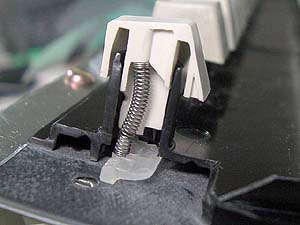
|
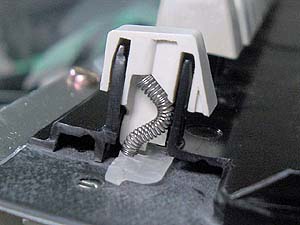
|
|
Inner
structure of a key top is designed to let the spring bend toward
designated direction only inside a key unit. When a
spring completely bends ( buckles ) , the spring hits actuator
and generates clicking sound and at the same time a platter ( or
hammer, whatever ) at
the end of the spring hits and press membrane sheets Membrane sheets are covered by
black rubber sheet . You can't see membrane sheets in above
pictures. |
Spring
and Platter
Coil springs and hammers used in model M2 ( including 42H0468 ) are
identical with those used in Model M.
Some models have black platters while the others have white
half-translucent hammers.
Those coils and platters can be interchangeable among all of model M
( of course except rubber spring M ).
Japanese readers are advised that coil springs in 5576-A01/003 are
different from those used in Model M. They are shorter than
Model M springs.
Pictures
below show deference of an actuating platter (hammer) of Model M and
Japanese A01
|
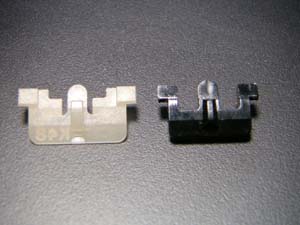
|
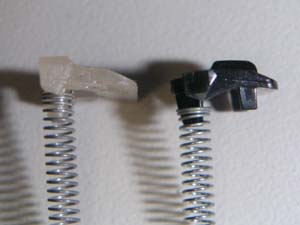
|
|
L; Model
M
R; Japanese A01
|
L; Model
M,
R; Japanese A01
|
|
|
|
|
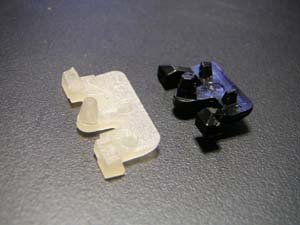
|
|
|
L; Model
M,
R; Japanese A01
|
|
|
|
|
|
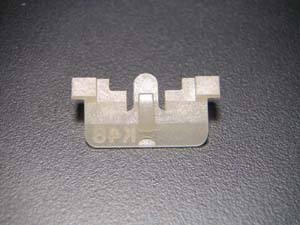
|
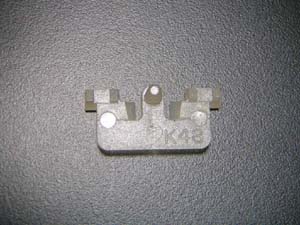
|
|
Bottom view
|
Upper view
|
|
|
|
|
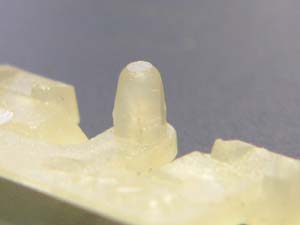
|
|
|
Upstanding post on the upper surface of a
platter.
|
|
Is
there any rule setting a spring onto a hammer ?
As far as I can see, every springs set on each hammers with a starting
point of coil spring locates within 180 to 270 degrees. Don't know
if there is any reason for it. If I set a spring in
different position, buckling error occurs frequently.
Replacing
bad springs
By what reason, a spring within a barrel got loosened or bent,
Spring got loosen or streched. Any way to replace to new spring ?
Basically, no. But if you really want to do, there is a way.
Please do it
by your own risk.
I learned following procedure from Mousefan,
the Authority of Switch. When you refer this method, This
should be also noted accordingly.
1. Prepare good springs ( probably you can get them from Unicomp.
or take them from defunct
donor boards.)
2. Make your own tool for surgery using a bamboo stick ( See
picture below )
When you make a similar rod, please make a
distinctive edge where you reduce diameter of
your bamboo stick. One in the picture is just an example to show
the method.
If the length of small diameter zone is too short,
you'll widen and loosen your new spring.
3. Pull out damaged spring.
4. Set a good spring at the end of a rod you made in step 2.
5. Set the rod together with spring into the barrel, then place
the spring onto the post ( tiny projection) on
a platter.
6. Push down the rod and turn ( rotate ) it slowly giving pressure
continuously.
You may think direction of rotating a rod should be
counter-clock wise according to M spring, but
I recommend you to turn your rod in counter clock
wise.
Diameter of a projection is wider then
that of M spring in order to hold a spring tight. If
the
post on a platter which is made of
plastic material happen to block the cut-end of a coiled spring,
and you still rotate the rod with
pressure, your spring may be loosen or stretched out.
But so far, both direction probably
may work. Do as you like.
|
|
|
|
Step 2.
Make a rod like this
|
Step 4.
Set a replacing spring
|
|
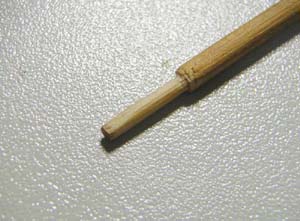
|
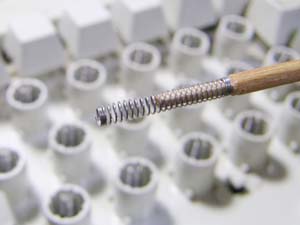
|
|
Step 5.
Insert the rod and place
spring on the post |
Step 6. Press down the rod and rotate it
|
|
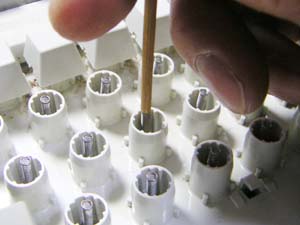
|
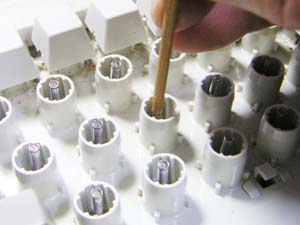
|
|
|
|
|
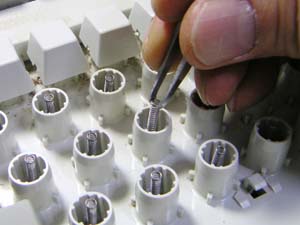
|
Check if your spring is set properly or not by
pulling it up gently.
|
|
|
|
How to remove springs securely from a donor board
Go to a drug store and get tweezers. Select thinner one. Grind inner
edges and make them in round shape.
|
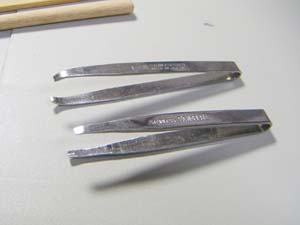
|
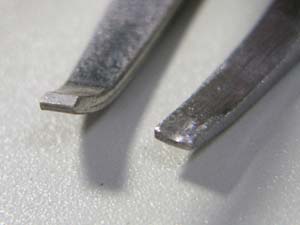
|
|
upper: normal lower:
grinded
|
left:
normal
right: grinded
|
|
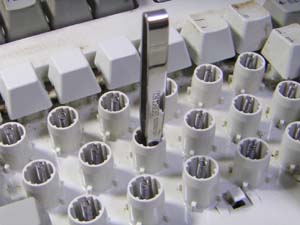
|
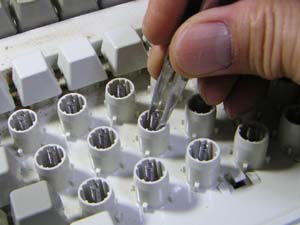
|
|
Insert your tweezers
into the barrel.
If you can't push it down to the post of a platter.
then grind and adjust width of your tweezers
|
Catch tight the end of the spring and pull it up.
If the spring is set tightly and you can't pull
it up,
then joggle it.
|
|
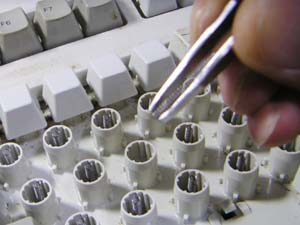
|
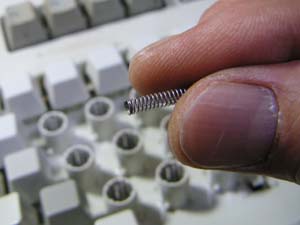
|
|
Here comes the sun
|
no comment needed against my fingers
|
How
to reduce Buckling sound
If you feel your M is too loud when you type and you want to reduce
buckling sound without changing your M to a cheapo membrane keyboard .
Use silicon grease. Pull out key
assembly and paste a little dose of silicon grease around the wall of
barrel and buckling springs. You can control sound level with the volume of
grease.
Spray type silicone grease is also easy to
use.
............And actually IBM provided such a
variant of Model M.
Model
F ; Buckling spring technology with capacitive switches
Model F was introduced together with the IBM PC. Key action is US
patented IBM Buckling technology and the switching system is so called
capacitive contacts switch. Capacitive switch does not require any
physical contacts between two terminals. Specially designed
electrical components detects changing of capacitance between
terminals and at some point
of capacitance, switch turns on. Model F uses plastic made
platters ( hammer lever ? ) to change capacitance of each switches, When a platter hits main PCB,
capacitance between two terminals on the PCB placed below a platter
increases and immediately a switch turns ON.
Capacitive switches made by other manufacturers such as Keytronic, BTC
and TOPRE ( a Japanese manufacturer which still makes very expensive
keyboards with capacitive switches ) do not generate clicky
sounds. Only IBM's model F with buckling system makes
louder clicking sounds when platters hit main PCB directly. Those who like IBM model
M may like IBM model F but those who does not like model M because of
its buckling sounds definitely dislike model F .
Because Model F is much louder than Model M when we
type. I like model F so much. Model
F AT 84 key keyboard is the one you can use with usual PCs without
any modification. You just need an AT to PS/2 cable to use the
keyboard.
English
explanation about Capacitive switch is available in this
web page.
The author misunderstand about mechanical switch because the author
introduced buckling mechanism of model F as an example of
mechanical switch. As far as Capacitive switch
concerns, the explanation seems to be correct..
Please
examine U.S. Patent No.4,188,611
for further detailed information.
Let's
see inner layout/parts of p/n 5640991
5640991
ID 380X N-1797
Date 47-1983,
Mod C-1,
Made in U.S.A. by IBM , Armonk. NY. USA
Description : One piece made key top, Buckling Spring
Technology, 15 pin D-sub connector. Data processing keyboard ?
|

|
|
Glass
fiber PCB is attached on the curved lower steel plate. PCB
itself is not flat but is also in a wide curve. |
|
Looking
from the bottom side of the lower steel plate
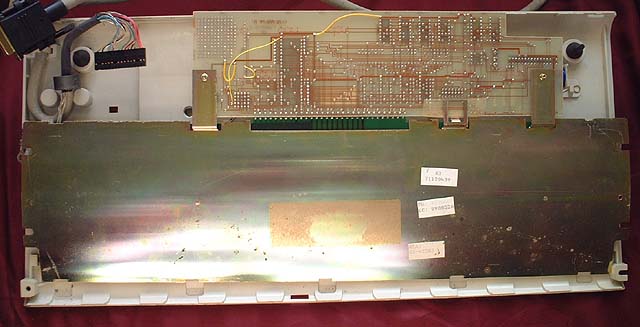
|
|

|
|
Left
side; Comparator?
A large DIP module might be a controller. It 's marked as
"8310354 8332, PI P A 998741, L3374976, Intel " |
|
Back
View of a controller PCB
|
|
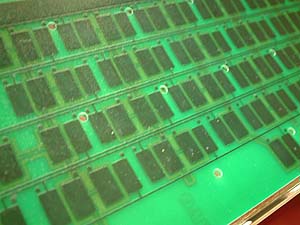
|
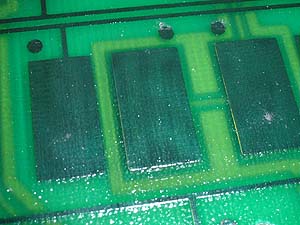
|
|
Some
kind of coating covers surface of the main PCB including every
terminals of signal line ( large square parts ) .
Look carefully a close look of terminals. You can identify no
cupper surface is exposed on the main PCB. |
|
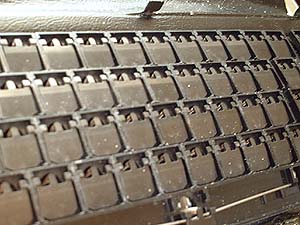
|
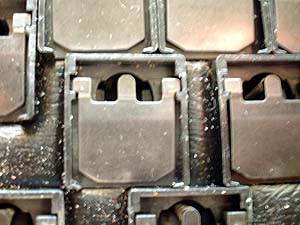
|
|
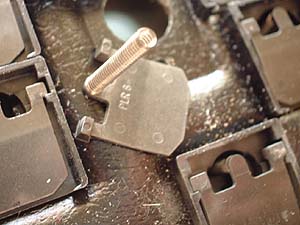
|
Wow!
Such a big plater ( blade, hammer lever , I don't know how
IBM named it. )
The lever is made of carbonized plastic.
When the key press downward and the plater meets terminals on
the PCB, capacitance between the terminals are increased
and then a switch turns ON. I don't know detailed mechanism. |
|
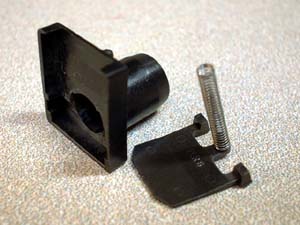
|
Every
actuators can be removed from metal base plate ( upper plate
). |
Do
not pull out a space bar from this keyboard ( I mean any kind of model F
keyboard. XT 83 key
keyboard and AT 84 key keyboard are
both included.) Stabilizing bar
is set underneath the upper metal plate and you can't place it properly
unless you disassemble the keyboard .
That's why I can provide above pictures. I knew that, but I just
forgot about it when I pulled out keys to make them
clean......
|
Front view of P/N 5640991 |
|
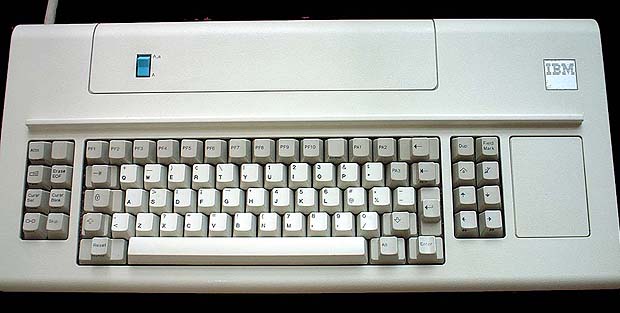
|
|
Keys except text/data keys may be
placed wrong position.
Forgot to take pictures before I pulled
out all the keys :-) |
Variations
of Control PCB
Also check Model
M keyboard section of Ardent
Tool web site maintained by Louis Orland.
|
K/B P/N
|
CTRL PCB
|
U2 P/N
|
RMRKS
|
|
1390120
|
1389989
|
1389986
|
|
|
1391401
|
1389989
|
1389986
|
|
|
1391401
|
1392993
|
1389986
|
|
|
1391401
|
1393291
|
1393295
|
|
|
1388032
|
1351523
|
1386032
|
Incompatible with Wintel PC
|
|
59G7980
|
1398011
|
1394080
|
|
|
1390680
|
1387210
|
1387213
|
Incompatible with Wintel PC
|
|
1319472
|
1390536
|
1390538
|
Space Saver M
|
|
42H1292
|
11A0162
|
1428578
|
Totally different from other PCB.
|
1389989
K23-3*1 EC528561 1087, dimension 170mm x
50mm
Pulled from Model M P/N 1391401, 13MAR87 made .
# 1087 following to EC
number probably indicates mfg week/year ( 10th week of 1987 ).
|
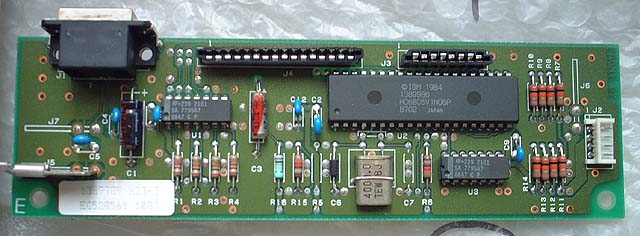
|
|
U1/U3
: 2392161 U2 : 1389986
|
There is a 4 pin header J2 at the right side of the PCB to which 4 yellow
wires from LED block are connected ( not a film printed cable ).
P/N
1390120 sold with the last PC/AT has the same control PCB.
*1
The number begins in K-prefix varies among models. For
example,
the number of a control PCB of model 1390120 in my
hand is " K26-1".
Signal assignment of connector J1
1392993
K26-1*1 EC 528682 3787, dimension
170mm x 50mm
Pulled from Model M 1391401 manufactured in 22SEP1987.
Almost same with 1389989 above. There are 2 capacitor packs at the
position of CP1 and CP2 below J4. Except these two
register packs, This PCB seems almost same with
1389989. ( I'm not so sure whether "CP"
means capacitor
packs or not. )
|
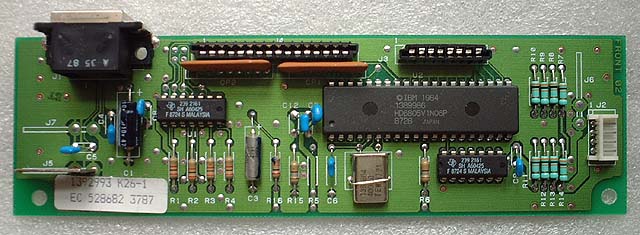
|
|
U1/U3
: 2392161 U2 : 1389986,
CP1 & CP2 : B9HC0114 102M x8
Two brown capacitor packs are soldered below J4 .
|
1351523
K26-3*1 EC528682 39/87, dimension 170mm x
50mm
|
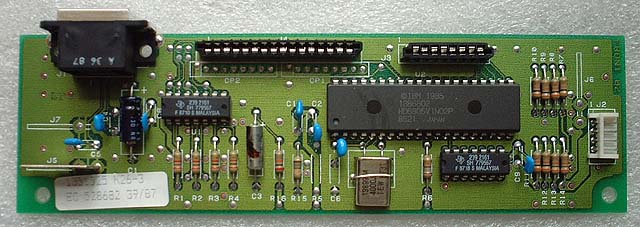
|
|
U1/U3
2392161, U2 1386802,
CP1/CP2 ; Solder pads
|
Looks like almost same with 1389989 1392993 except missing 2 brown capacitor
packs below J4. There are
solder pads at the position CP1 and CP2 . Main control
chip is different from above 2 PCBs.
This PCB is used in Gray color model M keyboard with a black square logo
plate , Part number 1388032, ID 1001377, Date 02OCT87, Plt J3
The keyboard doesn't work with a usual PC ( I mean Wintel PC not a
genuine PS/2, don't know if if works with a PS/2 ) . I don't know
if those missing CP1/CP2 blocks have some effects on this issue.
Or if the difference of controller chip P/N causes the problem...
When I swap the control PCB to a 1392993, the keyboard works
properly.
2004.06.27
Examined DC level of data/clock line and found each lines are something around 2.1V while others keyboards are around 4.8V.
Then I tried data/clock line modification adding 2x 4.7K ohm
registers according to IBM
PS/2 Keyboard modification page ( revived from internet archives.
Original page is now missing ).
Result ; No luck.. Three LEDs flashed repeatedly and PS/55E gave
301 error again.
Conclusion : Model M P/N 1388032 with a controller PCB P/N
1351523 might be a proprietary keyboard for some special
system. Most possibly Keyboard controller is not
compatible with usual PCs. ( Or mine has a defective
controller PCB )
1393291
KF530-3, EC 528693 4488
Made in 44th week 1988? ( Mfg date of the keyboard is
25OCT88 )
|
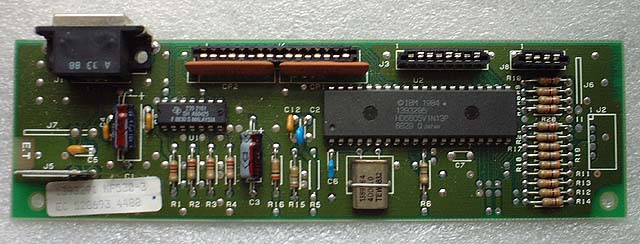
|
|
U1/U3
: 2392161 U2 : 1393295
Connector at J2 is missing, instead there is J8
for film cable connector for LED block
|
Seems
to be a popular type of control PCB used in earlier type of Model M between
1988 and 1990 .
Main difference is connection between a control PCB and LED block. Each
PCBs are connected via film cable instead of wires with 4 pin headers.
Variations of this PCB in smaller dimension can be seen in Louis's
page.
1398011
PCB is
pulled from a Model M P/N 59G7980 by Lexmark with drain holes, blue logo on a
gray round plate, manufactured 02FEB1993.
Film cable for LED block is combined with matrix lines and connected to J3 on the PCB together with
key matrix lines. This PCB is made in HongKong.
1387210
K26-3,
EX528635 0987, possibly made in HongKong
Pulled
from 101key terminal keyboard ( not sure ) Model M P/N
1390680, MFG date 02MAR87.
J7: 6pin connector ( Uses 4 pins only , 5 pins are ready ) for keyboard
cable.
J6: Unknown , shortened to PCB GND with a metal alloy.
U2: IBM 1387213 ( HD6805V1NO1P )
At the end of the cable, it has a strange AT like sideway
plug. You can see a picture of the same plug and the pin out can
be seen in this
page .
Pin out of connector J7, 5 pin header ( on the controller PCB )
|
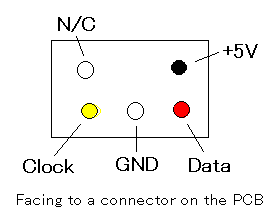
|
Bottom
left : Clock , to
the Yellow cable
Bottom center : GND , to the White cable
Bottom right : DATA, to the Red cable
Upper right : +5V , to
the Black cable
|
|
|
|
Keyboard
p/n 1390680 has very funny characters at the position of Numeric
Keys. Numeric keys are available at the upper row of text/data
keys ( below Function keys ) .
This Control PCB does not work on with
Windows PC.
1394523
EC. 528735
Pulled
from 122 key terminal keyboard P/N 1394099 , MFG date 05-05-97,
manufactured in UK by IBM ( not Lexmark ).
Cable connector is marked as J1.
J5/12 pin header connector is left open. ( no cables are connected ).
U2 P/n is 1394068 ( EF6805U3P-BE512 ).
Not sure about a plug at the cable end ( the cable was cut at the
keyboard side . I got the keyboard for "parts" )
. I assume the plug might be either RJ11 or RJ45.
1390536
EC528682, K23-3, 5287
|
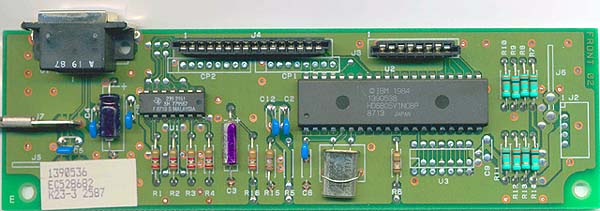 |
|
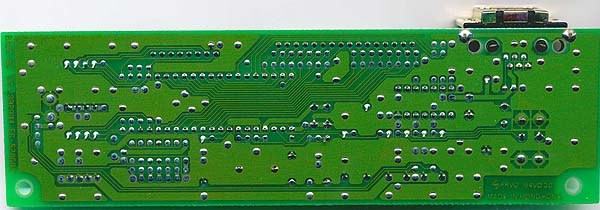
|
|
U2
: 1390538,
CP1/CP2 : Solder pads are there.
J2 connector for LED block is missing
U2 : Absent ( outline only )
Pulled from Space Saver Model M P/N 1319472, Date
15JUN87.
|
|
Model
M can't be recognized when connected to some modern mother board
Mr. John Szybowski
reported that model M can't be used
properly when it is connected to some newer mother board with faster
processor. This problem can be solved according to John's method.
Unfortunately his web page is no longer exist. However the page
was salvaged from internet archive and now stored at 9595
- Ardent tools of Capitalism by Louis F Ohland.. If you can't
reach the page, Click HERE
.
|






















